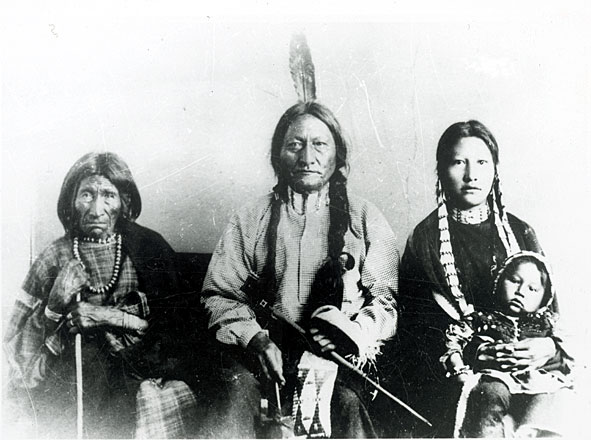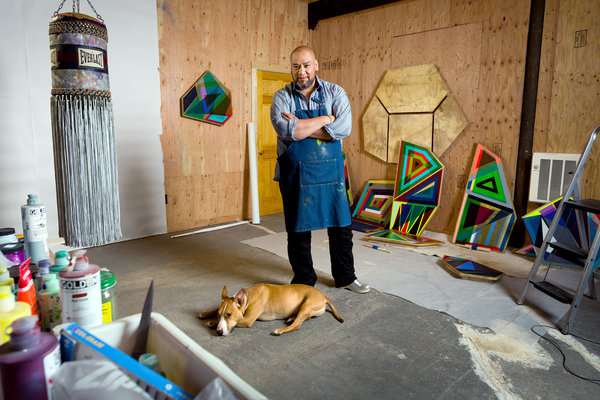Tag: Choctaw
5 Native American Communities Who Owned Enslaved Africans
April 9, 2014 | Posted by Barbara-Shae Jackson
The Atlanta Black Star
Stories about Black and Native American connections are rarely told within the narrow historical context shared in classrooms, history books and around family tables, but there are some details that reveal a more complete story of enslavement in the Americas.
In the 1830s, the enslavement of Blacks was established in the Indian Territory, the region that would become Oklahoma. By the late 19th century, when over half a million Africans were enslaved in the South, the southern Native American societies of that region had come to include both enslaved Blacks and small numbers of free Black people.
Though the harsh treatment of enslaved Africans largely paled in comparison to that of white slaveholders, Blacks still were treated as an underclass among Native Americas. The Five Civilized Tribes even established slave codes that protected owners’ property rights and restricted the rights of Blacks.
Here are the Five Civilized Tribes who held Black people as slaves.

Chickasaw
It is no surprise that the Native Americans knew the land well. Their knowledge became a lucrative business, especially for the Chickasaws who had keen navigation skills. They were hired by white slaveholders to traverse the terrain to capture Blacks who had escaped slavery.
The Chickasaw also held enslaved Africans of their own, and the system they established closely approximated that of white slaveholders on cotton plantations.
For rest of list please click here.
At Peace With Many Tribes, Jeffrey Gibson Mixes American Indian Forms and the Abstract

Jeffrey Gibson in his studio in Hudson, N.Y., with his dog, Stein-Olaf.
By Carol Kino, The New York Times
HUDSON, N.Y. — One sunny afternoon early this month Jeffrey Gibson paced around his studio, trying to keep track of which of his artworks was going where.
Luminous geometric abstractions, meticulously painted on deer hide, that hung in one room were about to be picked up for an art fair. In another sat Mr. Gibson’s outsize rendition of a parfleche trunk, a traditional American Indian rawhide carrying case, covered with Malevich-like shapes, which would be shipped to New York for a solo exhibition at the National Academy Museum. Two Delaunay-esque abstractions made with acrylic on unstretched elk hides had already been sent to a museum in Ottawa, but the air was still suffused with the incense-like fragrance of the smoke used to color the skins.
“If you’d told me five years ago that this was where my work was going to lead,” said Mr. Gibson, gesturing to other pieces, including two beaded punching bags and a cluster of painted drums, “I never would have believed it.” Now 41, he is a member of the Mississippi Band of Choctaw Indians and half-Cherokee. But for years, he said, he resisted the impulse to quote traditional Indian art, just as he had rejected the pressure he’d felt in art school to make work that reflected his so-called identity.
“The way we describe identity here is so reductive,” Mr. Gibson said. “It never bleeds into seeing you as a more multifaceted person.” But now “I’m finally at the point where I can feel comfortable being your introduction” to American Indian culture, he added. “It’s just a huge acceptance of self.”
Judging from Mr. Gibson’s growing number of exhibitions, self-acceptance has done his work a lot of good. In addition to the National Academy exhibition, “Said the Pigeon to the Squirrel,” which opens Thursday and runs through Sept. 8, his pieces can be seen in four other places.
“Love Song,” Mr. Gibson’s first solo museum show, opened this month at the Institute of Contemporary Art, Boston, with 20 silk-screened paintings, a video and two sculptures, one of which strings together seven painted drums. The smoked elk hide paintings are now on view in “Sakahàn,” a huge group exhibition of international indigenous art that opened last Friday at the National Gallery of Canada in Ottawa. And an installation of shield-shaped wall hangings, made from painted hides and tepee poles, is at the Cornell Fine Arts Museum at Rollins College in Winter Park, Fla.
Mr. Gibson also has work in a group exhibition at the Wilmer Jennings Gallery at Kenkeleba, a longtime East Village multicultural showcase through June 2. Called “The Old Becomes the New,” it explores the relationship between New York’s contemporary American Indian artists and postwar abstractionists like Robert Rauschenberg and Leon Polk Smith who were influenced by traditional Indian art. Mr. Gibson’s contribution is two cinder blocks wrapped in rawhide and painted with superimposed rectangles of color, creating a surprisingly harmonious mash-up of Josef Albers and Donald Judd with the ceremonial bundle.
The work’s hybrid nature has given curators different aspects to appreciate. Kathleen Ash-Milby, an associate curator at the Smithsonian National Museum of the American Indian in Lower Manhattan, said she loved Mr. Gibson’s use of color and his adventurousness with materials, and that he has “been able to be successful in the mainstream and continue his association with Native art and artists.” (Ms. Ash-Milby gave Mr. Gibson his first New York solo show, in 2005 at the American Indian Community House.)
Marshall N. Price, curator of the National Academy show, said he was drawn by Mr. Gibson’s drive to explore “both the problematic legacies of his own heritage and the problematic legacy of modernism” through the lens of geometric abstraction. (Which, he noted, “has a long tradition in Native American art history as well.”)
And for Jenelle Porter, the Institute of Contemporary Art curator who organized the Boston show, it’s Mr. Gibson’s ability to “foreground his background,” as she put it, in a striking and accessible way. Ms. Porter discovered his work early last year, in a solo two-gallery exhibition organized by the downtown nonprofit space Participant Inc.
“People were raving about the show,” she said. “So I went over there and I was absolutely floored.”
The work was “visually compelling, and not didactic,” she added. And because “he’s painting on hide, painting on drums, you have to talk about where it comes from.”
Mr. Gibson only recently figured out how to start that conversation. Because his father worked for the Defense Department, he was raised in South Korea, Germany and different cities in the United States, so “acclimating was normal to me,” he said. And one of the most persistent messages he heard growing up was “never to identify as a minority,” he added.
At the same time, because much of his extended family lives near reservations in Oklahoma and Mississippi, Mr. Gibson also grew up going to powwows and Indian festivals. He even briefly considered studying traditional Indian art, but instead opted to major in studio art at a community college near his parents’ house outside Washington. In 1992, he landed at the School of the Art Institute in Chicago.
There, Mr. Gibson, who had just come out as gay, often felt pressured to examine just one aspect of his life — his Indian heritage, with its implicit cultural sense of victimhood — when what he really yearned to do was to paint like Matisse or Warhol. At the same time, he was learning about that heritage in a new way as a research assistant at the Field Museum aiding its compliance with the 1990 Native American Graves Protection and Repatriation Act.
As he watched the Indian tribal elders who frequently visited to examine the drums, parfleche containers, headdresses and the like in the Field’s collection, Mr. Gibson was struck by their radically different responses. Some groups “would break down in tears,” he said. “Or there would be huge arguments.”
He came to see traditional art then “as a very powerful form of resistance” and to better “understand its relationship to contemporary life.” And nothing else he’d encountered “felt as complete and fully formed as the objects themselves,” he said. “It certainly made it difficult for me to go into the studio and paint.”
Yet paint Mr. Gibson did — mostly expressionistic landscapes filled with Disney characters, like Pocahontas, and decorated with sequins and glitter. His work continued in a similar vein while he was earning his M.F.A. at the Royal College of Art in London. Although the Mississippi Band paid for his education, the experience gave him a welcome break from grappling with concerns about identity, he said, and a chance “to just look at art and think about the formal qualities of making an artwork.” (Along the way, he also met his husband, the Norwegian sculptor Rune Olsen.)
After returning to the United States in 1999, this time to New York and New Jersey, Mr. Gibson began painting fantastical pastoral scenes, embellishing their surfaces with crystal beads and bubbles of pigmented silicone, recalling 1970s Pattern and Decoration art. Those led to his first solo show with Ms. Ash-Milby in 2005, and his inclusion in the 2007 group show “Off the Map: Landscape in the Native Imagination” at the National Museum of the American Indian, as well as other group shows.
At the same time, Mr. Gibson was making sculptures with mannequins and African masks. While struggling to understand Minimalism, he also began to see the connection between Modernist geometric abstraction and the designs on the objects that had transfixed him in the Field’s collection.
His 2012 show with Participant, “One Becomes the Other,” proved to be a turning point. In it, he collaborated with traditional Indian artists to create works like the string of painted drums, or a deer hide quiver that held an arrow made from a pink fluorescent bulb. And once he set brush to rawhide, Mr. Gibson said, he was hooked. As well as being “an amazing surface to work on,” he said, “its relationship to parchment intrigued me.”
Its use also “positions the viewer to look through the lens that I’d been working so hard to illustrate.”
But the underlying change, Mr. Gibson added, came from his decision to shed the notion of being a member of a minority group. Suddenly all art, European, American and Indian alike, became merely “individual points on this periphery around me,” he said. “Once I thought of myself as the center, the world opened up.”

